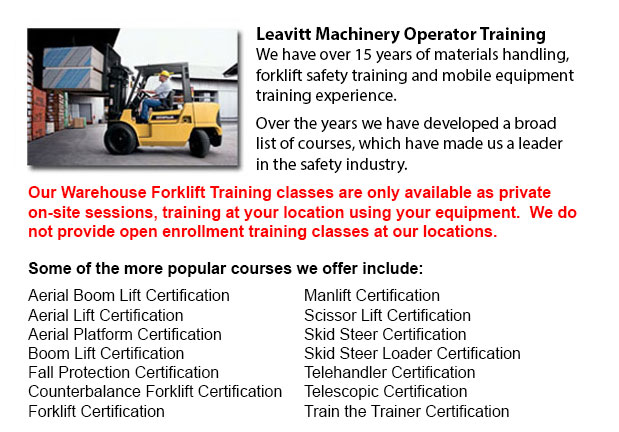
Oakville Warehouse Forklift Training Programs - Warehouses could be retail, industrial or commercial facilities. Their function can differ from retailing bulk products to product distribution. Regardless of the type of warehouse, staff in warehouse settings should be well trained in safety measures related to material handling and storage, conveyor systems, loading docks, and pallet jacks and forklifts. Good housekeeping is vital to an orderly and safe warehouse environment.
Truck and loading dock systems are often located at a height from the ground. Products enter and exit warehouses through these systems where personnel load and unload things from elevated docks and ramps. Particular attention must be paid to safety habits throughout this stage. To prevent falls, install yellow striping along the edge of ramps and docks. Pay attention to the area around delivery trucks which are parked at the loading dock, specifically the part between truck and dock. Be sure that truck wheels are chocked when unloading.
Some warehouses make use of conveyor systems to distribute products inside the facility. Conveyor systems have moving belts and wheels which pose a pinch point hazard. Keep parts of the body and hair far away from conveyors to prevent injury. Elevated conveyors pose a hazard to personnel under if safety nets are absent. Staff have to know how to stop conveyors in case of emergency. Be aware of the location of emergency stop buttons and off switches. When servicing conveyors, tag out/lock out procedures are mandatory.
To make it easier to transport materials, forklifts are pallet jacks are most commonly used. The operator of the lift truck would need training and certification. Operators of pallet jacks do not need certification, but should be trained about the machinery. Training programs instruct operators in the right methods for hoisting objects and moving them to their assigned location. Neither pallet jacks nor forklifts must ever be made use of to transport or lift personnel.
Storage shelving and rack systems help to create an orderly and efficient work space if they are sturdy, braced, and allow enough room for people and machinery to pass. Slow and careful placement of good is required to prevent accidents caused by products falling off the facing aisle. Aisles should be kept clear by storing products flat and within the shelving units. Pallets are used for stacking products. They should be in good condition, and palleted products should be baled or shrink-wrapped, whenever possible.
PPE or likewise referred to as personal protective equipment should be worn when needed to help protect the employees' heads, limbs, hands and feet. Bump caps or hard hats, gloves and steel-toed shoes are common PPE.
Slippery floors pocked with dents and pits present a hazard. Good housekeeping practices include keeping warehouse docks and floors clear of oil, dirt and debris. The area should be kept clear of boxes, baling materials and trash.
-
Oakville Overhead Crane Safety Training
Oakville Overhead Crane Safety Training - Overhead crane safety training equips operators with skills and knowledge regarding crane safety measures, accident avoidance, materials handling, and machinery and stock protection. Trainees will learn the t... More -
Oakville Crane Training Schools
Oakville Crane Training Schools - Our various Mobile Crane Operation programs are designed for skilled operators who needs re-certification or certification, and for inexperienced individuals who are seeking their very first job as an operator of a c... More -
Oakville Overhead Crane Certification
Oakville Overhead Crane Certification - The overhead crane certification course is a course that is designed to help trainees, even though they have language or literacy limits. The course consists of a classroom theory part and a practical hands-on... More -
Oakville Forklift Training Programs
Oakville Forklift Training Programs - If you are searching for work as an operator of a forklift, our regulatory-compliant forklift training programs provide exceptional instruction in various types and styles of forklifts, classes on pre-shift inspe... More -
Oakville Fall Protection Ticket
Oakville Fall Protection Ticket - The number one cause of death in the construction business come from fall-related accidents. There is more possibility for fall accidents depending on the types of work being performed within your workplace. Thus, be... More -
Oakville Zoom Boom Training
Oakville Zoom Boom Training - Zoom Boom Training focuses on correctly training potential operators on variable reach forklifts. The training objectives consist of gaining the understanding of the machine's physics and to define the job of the operato... More -
Oakville Aerial Lift Ticket
Oakville Aerial Lift Ticket - A boom truck is often recognized by the cable and telephone company vans that have the elongated arm folded over their roofs. Commonly, a bucket-like apparatus sits at the extension of extendable arms. Often referred to... More -
Oakville Scissor Lift Training
Oakville Scissor Lift Training - Scissor lifts need to be operated competently to be able to protect the safety of the machinery and the safety of people in the workplace. Operators who are skilled are trained to drive the specific model of scissor l... More

Forklift Certification Oakville
TOLL FREE: 1-888-254-6157
Oakville, Ontario
forkliftcertificationoakville.com
Email Us
About Us


